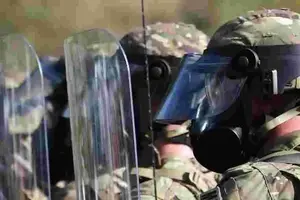
Hours before law enforcement officers violently cleared protesters from a square outside the White House in June, a top military police officer sought out weaponry like powerful sound cannons and a device that "causes targets to feel an unbearable heating sensation", an army national guard major told legislators in written testimony.
Major Adam DeMarco, an Iraq war veteran who serves in the District of Columbia national guard and was called in to enforce the crackdown on protesters, told House legislators the previous month that he had received an e-mail from a top law enforcement official at the Defence Department asking if the Guard was equipped with sound cannons or a non-lethal heat ray, known as an active denial system, or ADS.
"ADS can provide our troops a capability they currently do not have," the officer wrote, according to Maj DeMarco's testimony, first reported by The Washington Post.
"The ADS can immediately compel an individual to cease threatening behaviour or depart through application of a directed energy beam that provides a sensation of intense heat on the surface of the skin. The effect is overwhelming."
Maj DeMarco also said that federal officials stockpiled "approximately 7,000 rounds" of live ammunition in the hours before the clash, transferring the munitions from as far as Missouri and Tennessee to the nation's capital.
The Guard ultimately did not have either device, Maj DeMarco said.
But the exchange, including the previously unreported disclosure that top military officials sought out controversial military-grade equipment, provides a window into the law enforcement response toward the peaceful demonstrators who had gathered outside the White House to protest against the killing of a black man, Mr George Floyd, while in police custody in May in Minneapolis.
A Defence Department official told The Post that the inquiries were "routine inventory checks to determine what equipment was available".
In an interview on Wednesday night (Sept 16), Mr David Laufman, the lawyer representing Maj DeMarco, dismissed that characterisation.
"This was an official inquiry made by a Department of Defence official into the availability of a heat ray to use against American citizens peacefully expressing their First Amendment rights," Mr Laufman said.
"There is nothing 'routine' about giving serious consideration to using such a device against our fellow citizens peacefully demonstrating in the streets of our nation's capital."
After a weekend of unrest this spring in Washington, the Trump administration deployed federal law enforcement throughout the city to quell demonstrations.
Outside the White House, in Lafayette Square, some of those forces used tear gas and stun grenades to clear a crowd of protesters so that Mr Trump could walk through to pose for photographs with a Bible at a church damaged by a small fire the night before.
Top administration officials have defended the reaction to the protests, arguing that law enforcement officers in the square in the days leading up to the clash had been met with violence from bad actors.
Testifying before Congress in July, Mr Gregory Monahan, the Park Police's acting chief, said that his officers acted with "tremendous restraint".
Top Republican legislators, as well as Attorney-General William Barr, have previously sought to discredit Maj DeMarco, noting that he ran as a Democratic House candidate in 2018.
Maj DeMarco, who also testified before the House Committee on Natural Resources as part of the panel's investigation into the clash, offered a starkly different picture, telling legislators that the police used "excessive" force on protesters.
The heat ray that officials had sought was developed with the intent of repelling individuals without injury.
But military news releases describe the technology as causing an "unbearable heating sensation", and a system deployed to Afghanistan with the air force in 2010 ultimately was never used and was withdrawn, in part, some speculated, because of public opposition.
In a meeting days before the 2018 midterm elections, Customs and Border Protection officials suggested using the device on migrants at the south-western border, but the idea shocked attendees, and Ms Kirstjen Nielsen, then the secretary of the Department of Homeland Security, angrily dismissed the idea outright.
Maj DeMarco, in his written testimony, also told legislators that military officials had sought out powerful sound cannons known as long-range acoustic devices, which can be used to loudly issue commands to crowds but can also serve as a deterrent.
A federal judge in New York ruled in 2017 that the sound the cannons emit could be considered a form of force, after the police used such a device to emit a series of piercing beeps directed at protesters who afterwards said they had developed ringing in their ears and dizziness because of the noise.